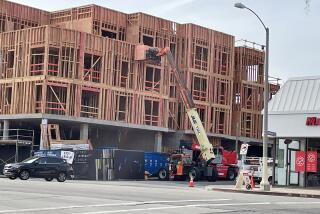Parking Spaces Putting on the Squeeze
- Share via
WOODLAND HILLS — The absurdist bit of urban theater plays itself out most every day at the Warner Plaza-Gateway Plaza shopping center, as drivers circle endlessly in their exasperating quest for a parking space. They are thrilled to find a spot near the Vons even if they shop at Ralphs, happy to settle for Starbucks though they really wanted Jamba Juice.
Any port in a parking storm.
What is it about this lot--and hundreds of others across Los Angeles--that makes it so difficult to negotiate? Overdevelopment? Awkward design? As much as anything, perhaps, it is the popularity of big cars on the heels of an era that promoted the “compact only” parking space.
“Look at that guy! He’s hogging two whole spaces!” one nearly hysterical driver cried recently near the Vons. Indeed, out of 16 vehicles in one row of compact spaces this day, only five might have been considered compacts. Five were large or mid-size cars. Six were what the auto makers have dubbed “light trucks”: a pickup, a minivan and four sport utility vehicles.
Parking here has always been tricky, with two independently owned shopping centers occupying a single busy corner. In fact, the compact parking, on the Warner Plaza side, is a recent attempt to accommodate shoppers by creating more spaces. But as some see it, the dozens of compact stalls shoehorned in last summer only underscore the growing influence of trucks.
The 16 vehicles lined up, for example, occupied 20 compact spaces--certainly not what efficiency-minded parking architects like to see.
But after the oil crisis of 1973 and the ensuing trend in the United States toward smaller, more fuel-efficient cars, perhaps only the Nostradamus of parking lot designers could have predicted that fuel-swilling sport utility vehicles would be the preferred transport of 1990s urbanites.
“The planners assumed that once we went small, we’d never go big again,” said William Fulton, author of “The Reluctant Metropolis: The Politics of Urban Growth in Los Angeles.” “They didn’t think gas would be $1.30 a gallon, they thought it would be $4 a gallon.”
A handful of smaller Southern California cities have tried to address the growing grumblings of frustrated parkers by banning the smaller spaces in new projects or eliminating both large and small spaces in favor of a mid-range, one-size-fits-all spot.
But with open real estate becoming ever more scarce in urban areas--and since there is little obvious financial incentive for developers to trade retail space for, say, roomier parking spots--the problem is not likely to be resolved any time soon. Nor is the question of which to blame, the small stall or the big car.
“I hate those truck things,” the angry driver said before she left the parking lot without finding an open spot. “And I hate those stupid little spaces too.”
*
Averaging about 7 feet, 6 inches wide by 16 feet long--instead of the standard 9-by-18-footer--the compact space has been employed by developers with big dreams and limited square footage since at least the early 1960s.
In the early 1970s, the city of Los Angeles decided to allow 20% of the average business’ required number of stalls to be compact. By the late 1970s, the diminutive slot was becoming wildly popular, planning experts say. Not only were Americans snapping up smaller Japanese and European cars, the cost of real estate was skyrocketing.
“For people who build buildings, parking is a necessary evil,” said Robert Hindle, vice president of Parking Concepts Inc., a Los Angeles company that operates 100 lots and parking structures in Southern California. Most, he said, operate on a simple premise: “You can put more compacts in 1,000 square feet than you can put large [spaces].”
Lest developers incur all the wrath of drivers with dinged car doors, however, there were other factions lobbying in years past on behalf of the now-maligned compact spot.
Energy conservationists viewed such stalls, if placed near the entrance to a store, as a way to reward the drivers of fuel-efficient cars. And urban planners, who strive to soothe the city dweller’s psyche as well as get him home on time, liked the idea of dedicating more space to humans and less to machines.
(Between 15% and 40% of the city’s surface is now reserved for parking, according to various estimates. If that makes Los Angeles sound like the world’s largest parking lot, it’s about in line with other American urban centers, as well as ancient Pompeii, said Mike O’Brien of the city Planning Department. About 15% of that doomed city was given over to that era’s parking-lot equivalent--horse stables.)
So, under pressure from such varying interests as mall builders and Yugo drivers, many cities retooled their ordinances over the years to allow a greater percentage of compact parking spaces. In September 1982, Los Angeles decreed that 40% of a business’ required number of parking stalls could be compact.
Although statistics are hard to come by, anecdotal evidence gathered by such people as Officer George Maycott of the Valley Traffic Division--who has spent 18 of his nearly 25 years with the Los Angeles Police Department working traffic--suggests that a decade ago a near-equilibrium existed between the number of compact cars and compact stalls.
Certainly, police weren’t responding to a fender-bender a day at some malls, as they sometimes do today during the holiday season, Maycott said. And the issue of hulking autos jamming into mini-spaces had not yet become a common topic of coffee-counter conversation.
But gas prices remained low, and car buyers focused on comfort and performance rather than fuel efficiency. Then came the modern sport utility vehicle, not to mention minivans and pickups with leather seats and bed-liners marketed for city dwellers.
Twenty years ago, trucks accounted for less than one of every five vehicles on the road. Today, nearly one of every two vehicles is a light truck.
In 1990, Americans bought 930,000 sport utility vehicles. This year, that number will hit 2 million, with Los Angeles and New York the largest markets, according to Ward’s Automotive Reports.
Although sales of sport utility vehicles are beginning to level off after several years of dramatic increases, according to automotive research firm JD Power & Associates, they are expected to remain strong well into the next century.
Despite the soaring popularity of large vehicles, the average car on the road today is not substantially larger than when the 1973 Arab oil embargo caused millions of Americans to think about gas mileage. The average size of the 10 best-selling vehicles in the U.S. is just an inch longer and virtually the same width, according to one study.
What has happened is that Americans are driving fewer small cars as well as fewer of the barreling monsters of yesteryear. Many of today’s most popular vehicles fall in the nebulous range known as “mid-size,” says Chuck Boldon, president of Sherman Oaks-based International Parking Design.
Lawndale Mayor Harold Hofmann, whose city has a full-blown ban on new compact stalls, put it this way: “Even compacts aren’t very compact anymore.”
Of course, a mid-size vehicle can wipe out a couple of good compact spaces almost as well as a Humvee can, especially if it’s poorly parked. Just ask Nino Belfortti, a pharmacy technician at Warner Plaza Pharmacy, whose Jeep Cherokee has been dented twice in a matter of months.
“The extra spots are good, but all the extra spots are too small,” he said.
That’s why Boldon advises many of his clients to consider the one-size-fits-all space, endorsed by the cities of Glendale, Santa Ana and Anaheim, among others. It’s bigger than the average small space and smaller than the average big one.
Then again, “one size fits all” is something of a misnomer, some contend, because it’s often a bit small for the largest sport utility vehicles, like Chevrolet’s Suburban and Ford’s Expedition, and larger than what’s needed by, say, the always-popular Volkswagen Beetle.
But the science of parking--which must take into account turning radiuses, the angle of the stall and numerous other factors--is anything but a pure one, as any driver knows.
Despite the daily parking-lot equivalents of “Waiting for Godot,” and despite the fact that Maycott and other traffic cops park their personal cars as far from the compacts as possible, the complaining has not reached a high enough pitch to pique the interest of city officials or mall operators.
“We’ve had one complaint,” said a Warner Plaza spokesman, who declined to give his name. Most shoppers, he said, love the extra parking spaces even if they’re small.
Councilwoman Laura Chick, whose district covers much of the notoriously difficult Ventura Boulevard, hasn’t heard any complaints at all. Same with the Planning Department’s O’Brien.
What may happen, some experts suggest, is that the marketplace rather than government bureaucracies may prompt widespread change. Any shrewd business owner, after all, wants to get customers in and out as quickly and efficiently as possible.
In the meantime, however, another phenomenon is likely to occur, said author Fulton: As the percentage of large and mid-size vehicles continues to grow, so will the number of drivers who believe their jacked-up four-wheel-drive with mag tires is really a compact car.
“See,” Los Angeles resident Max Walters said with a sly grin after jamming his bulky Toyota 4-Runner into a compact space at Warner Plaza. “It fits.”






